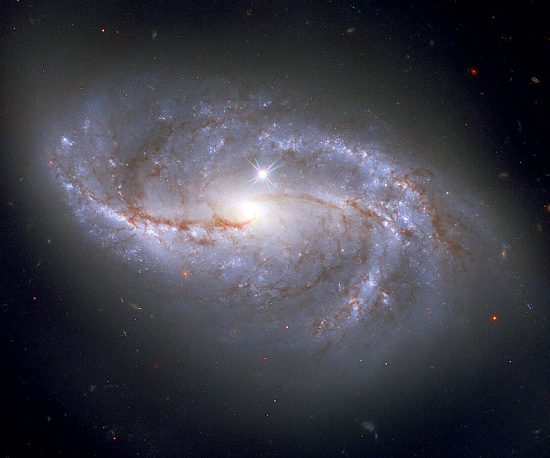
June 15, 2020
As written many times in the past, stellar evolution is conventionally thought to proceed from compressed clouds of hydrogen and helium, which derive their energetic emissions from thermonuclear processes.
NGC 2608 is considered an example of those activities, because astronomers find that the galaxy’s spiral arms exhibit high-energy X-rays and extreme-ultraviolet light. The image at the top of the page exhibits lengthening of the galactic arms beyond what is seen in visible-light: they shine with an intensity that cannot be explained only through the mechanical compression of molecular hydrogen.
Plasma science pioneer, Winston Bostick is noted for his work with laboratory-scale plasmoid experiments and the construction of a dense-plasma focus device. One of his major contributions to astrophysics is the controversial hypothesis regarding the way that galaxies mature from initial quasi-stellar (QUASAR) conglomerations of plasma.
Bostick saw the Universe as a continuous process of charge flow through the plasmas that form its substance, so his analysis of galactic behavior is based in electricity. Against a background magnetic field, electricity flows in the form of invisible Birkeland current filaments. The induced rotation of Birkeland current pairs, where they intersect, is responsible for the formation and rotation of galactic discs, such as NGC 2608, and the production of the characteristic spiral arms. Electric current flows in from the extra-galactic environment to the edges of the galactic disc, where it then twists upward and downward along the rotation axis in response to magnetic fields. It then completes its circuit by spiraling back down to the edge of the disc.
Plasma is compressed within the vortical filaments in long lines extending out from the galactic nucleus—sometimes the “lines” are seen in galactic images as “bars” that spin at right angles to the current flowing out of the central bulge. It is in the most dense current flows where stars form. The stars shine not because of gravitational forces, but because of the electric nature of the Universe and the way that moving plasma behaves in electromagnetic fields.
How many times will NASA ignore the obvious conclusions and admit that electrical forces are creating X-rays and the “mysterious” arms that they see? By relying on gravity and “hot gas” as their only recourse, the effects of charged plasma in space are not given credence. Therefore, Birkeland currents, and the twisting formations when they pass through ionized plasma, are not mentioned. Nor is the way that X-rays and other high energy emissions are generated by z-pinch effects in such currents discussed. Electricity in space is discounted as a source for observations, because astrophysicists aren’t trained to consider it. Ignoring that information will create even more mysteries instead of answers, and more problems will be produced instead of resolving the old ones.
Stephen Smith
The Thunderbolts Picture of the Day is generously supported by the Mainwaring Archive Foundation.












